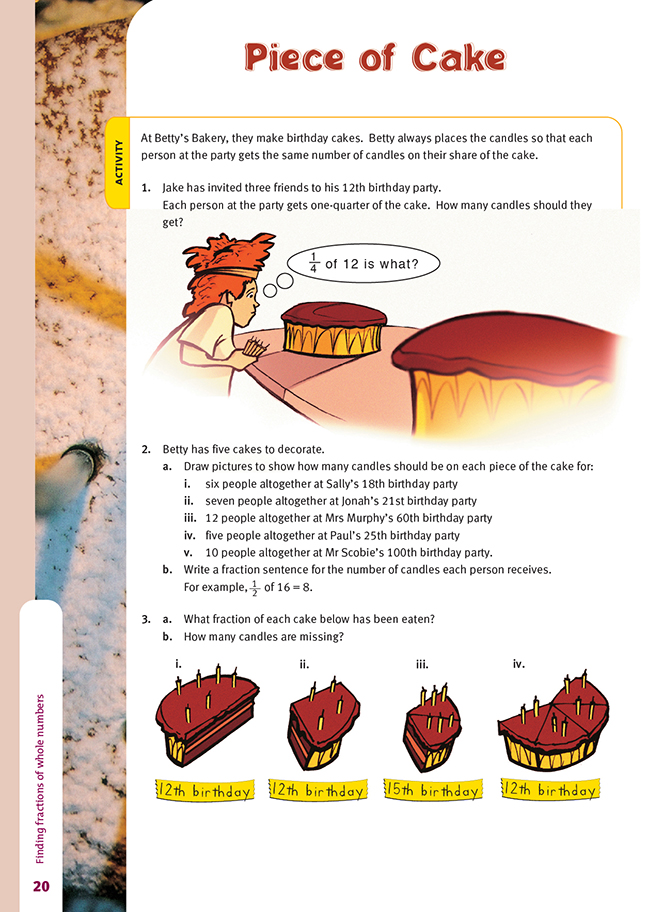This is a level 2 number link activity from the Figure It Out series. It relates to Stage 5 of the Number Framework.
A PDF of the student activity is included.
Click on the image to enlarge it. Click again to close. Download PDF (222 KB)
find fractions of whole numbers
FIO, Link, Number, Book One, Piece of Cake, page 20
This activity develops the idea of finding a fraction of a set of objects by connecting the fraction of a region concept, modelled as a cake, with the idea of sets, as modelled by the candles.
Emphasise that the whole to which the fractions refer is the cake and that, in this scenario, the candles will be placed evenly over the cake so that each equal-sized piece will have the same number of candles.
The students need to understand how the numbers combine in an integrated manner when they are recording the notation for fractions. In the notation recorded as 2/5 , the students need to know that the numerator, 2, refers to the number of parts being considered. The denominator, 5, refers to how many parts the whole (unit) is being divided into.
The drawings in question 2 do not need to be accurate, but they should be reasonable approximations for the correct number of equal parts. Have the students write their equations using the word “of ” as well as the “x” symbol so that they can make a meaningful connection. For example, 1/2 of 16 = 8 and 1/2 x 16 = 8.
Question 3a can also be used to show equivalent fractions. In problem 3a i, one-half of the cake has six out of 12 candles. This is recorded as 1/2 = 6/12. In problem 3a ii, two-thirds of the cake has eight out of 12 candles: 2/3 = 8/12.
Make sure that the students understand that one whole cake can also be described as a fraction by asking them to combine the parts eaten with the parts left as a way of checking their calculations. These can be recorded as addition equations, for example, for 3b i, 6/12 + 6/12 = 12/12 = 1 and for 3b iv, 8/12 + 4/12 = 12/12 = 1.
Answers to Activity
1. 3
2. a–b. Pictures will vary. Possible fraction sentences are:
i. 1/6 of 18 = 3 (so the picture should show three candles on each sixth)
ii. 1/7 of 21 = 3 (so the picture should show three candles on each seventh)
iii. 1/12 of 60 = 5 (so the picture should show five candles on each 12th)
iv. 1/5 of 25 = 5 (so the picture should show five candles on each fifth)
v. 1/10 of 100 = 10 (so the picture should show 10 candles on each 10th)
3. a. i. 1/2
ii. 2/3
iii. 3/5
iv. 2/6 or 1/3
b. i. 6
ii. 8
iii. 9
iv. 4
